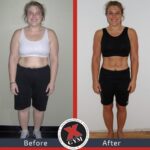 Lots of X Gym clients come to me asking about their protein needs and requirements. The research varies widely on this and frankly, I don’t think we even fully know the answer to this question yet. Research has shown that protein is a high metabolic food and most sources build muscle and burn fat, so that’s good enough for me to eat it – even in excess of what I can absorb.
Lots of X Gym clients come to me asking about their protein needs and requirements. The research varies widely on this and frankly, I don’t think we even fully know the answer to this question yet. Research has shown that protein is a high metabolic food and most sources build muscle and burn fat, so that’s good enough for me to eat it – even in excess of what I can absorb.
Excess protein raises your metabolism and makes you leaner, because your body has to do something with that energy. It doesn’t want to convert it into fat because that’s more work than just burning it off, so it chooses to do the latter by increasing your metabolic rate.
Another reason excess protein helps make you lean is because your body keeps fat on reserve to prevent starvation, but when you eat more protein than you need, it signals your body to dump the fat because you are obviously getting plenty of food.
I eat between 200-400 grams of protein per day, depending on how hungry I am. I do this because it tastes great to me, gives me energy, and it keeps my metabolism humming along all day. This is my biggest tool for staying lean and maintaining muscle, which is a huge contributor to my metabolism. I only exercise for less than an hour per week, so I need assistance through my diet to keep me lean and strong.
So what about the nay sayers who claim protein isn’t all that necessary? My friend Tim Van Orden is a raw vegan and he claims that he gets all his protein needs without the need for animal products. He is indeed in phenomenal shape, and has the time and energy to exercise for hours per week. That’s great for him and he has certainly found success with that lifestyle, but like my lifestyle, it’s not for everyone.
How about the critics who claim excess protein is hard on your organs and bad for your health? Well, if you are talking about eating conventional meat, they are right. That stuff will kill you fast. Clean meat (wild, organic, grass fed, free range, etc.) is actually good for you. Most of this field of thought comes from a research study using subjects who had compromised kidney function. This got out into the mainstream and was extrapolated to healthy individuals. People with normal kidney function can handle protein just fine. Other myths about organ strain caused by protein have circulated as well, most promoted, popularized and publicized by the vegan community. If protein was so harmful, then the Eskimos would be in deep trouble because 98% of their calories come from animal products (at least until the western world introduced them to our junk food).
The USRDA for protein is about 60 grams a day. Most people don’t realize that the USRDA numbers are the MINIMUM recommended amounts of nutrients to PREVENT DISEASE. These are not the recommendations for us to THRIVE. The USRDA will merely keep you alive without getting nutritional deficiency symptoms. To thrive however, we need more – much more – of most of these nutrients.
So, how much more? Well, from what I’ve studied, about 1 gram per pound of bodyweight will make sure you are getting as much as you can absorb (for those who weigh between 100-250 lbs.). For me that’s 165 grams. At 200-400 grams per day, I eat more than I can absorb, but that’s OK because the excess just bumps up my metabolism and makes me leaner. I’m fine with that, and it’s yummy to me, so I get to eat excess for pleasure and reap the benefits of a lean body at the same time. Pretty good deal huh?
What about for exercise? Isn’t it better to carb load for energy or do you need protein for building muscle? I read an email recently from Al Sears, a doctor I respect. He put it better than I could:
I just read a study in Exercise and Sport’s Science Review that shows why doing the opposite and ditching the carbs before you exercise is much better for you.1
In fact, I’ve read another study showing that people who stayed away from carbs before their workouts for 10 weeks gained “superior exercise capacity.”2
That’s because eating fewer carbs improved their “training adaptation.”
Training adaptation is your body’s ability to adjust to the physical demands you place on it. For example, when you start a new workout, you feel sore. But training adaptation gets you used to the new exercise, so you don’t get the sore feeling anymore.
Some of the more advanced athletes even use this method they now call “training low” – to train with few carbs in your body – as a replacement for the old method of the high-carb diet.
So if it’s not carbs, then what should you do for energy before a workout?
1. Eat the right protein: The first thing you want to remember is that protein isn’t just something you eat to “replace” what you lose in a workout. Protein is how your body sustains and metabolizes energy during and after your workouts.
The best source for protein before a workout is whey protein. Just make sure that the whey is from grass-fed beef sources. The whey protein cultivated from grain-fed cows is compromised and denatured. You get all the hormones and antibiotics that were pumped into the cow, which may even be in a more concentrated form.
2. Eat the right fat: You also can get energy before a workout or an athletic event by snacking on some fat. That’s right, fat. Remember, good fat is good for you. The best kind of fat you can take in before exercise is Alpha-linolenic acid or ALA. This powerful omega-3 fatty acid gives you energy that lasts longer than carbs.
Here are some foods naturally high in ALA that are perfect for pre-workout meals or snacks:
Walnuts Free-Range Eggs Dark Green Leafy Vegetables Wild-caught Atlantic Salmon Haas Avocados Sardines Butternuts Brazil Nuts Pumpkin Seeds Albacore Tuna
Black and red currant seeds also are good plant-based sources of ALA. But the world’s best source of ALA from plants is Sacha Inchi Oil from Peru. It’s nearly 50 percent pure ALA. You get almost 7 grams of omega-3 in each tablespoonful.
To Your Good Health,
Al Sears, MD
1 Hawley, J., Burke, L., “Carbohydrate Availability and Training Adaptation: Effects on Cell Metabolisms,”Exercise and Sport Sciences Reviews 2010
2 Hansen, Anne K., et al, “Skeletal muscle adaptation: training twice every second day vs. training once daily,” Journal of Applied Physiology January 2005; 98 (1): 93-99
3 Hall, et al, The effectiveness of Tai Chi for chronic musculoskeletal pain conditions: A systematic review and meta-analysis. Arthritis & Rheumatism 2009; 61 (6): 717
4 Wang C., et al, “A Randomized Trial of Tai Chi for Fibromyalgia,” The New England Journal of Medicine2010; 363:743-754










